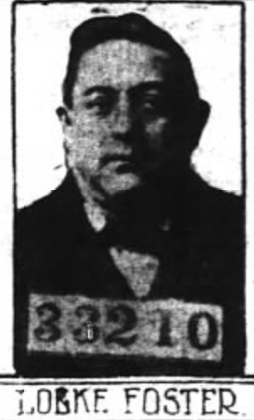 The Cincinnati Enquirer, May 10, 1901. On the night of September 11, 1900, William C. Johnson was shot and killed during the robbery of his home by five masked men in Wyandot County, Ohio. Johnson, a prominent farmer known as the “Celery King,” operated the Wild Rose Celery Farm north of the town of Carey, and it was said that he kept large amounts of cash in his house.
Following Johnson’s murder, five men were arrested but released soon after, for reasons that were not made public. In early 1901, Ben Landis was arrested for stealing a horse near Carey. While in jail, Landis told Wyandot County’s Sheriff G.W. Cliffe that he had information about Johnson’s murder. Landis met with Cliffe and provided him with the names of the men he said were the culprits: George Ury, Marsh Lindsay, Willis Miller, Charles Foster, and Locke Foster, all reputedly members of a local band of criminals known as the “Foster Gang.” After providing these names, Landis was released on his own recognizance.
In early March 1901, Cliffe arrested the five men implicated by Landis.
On May 1, 1901, 68-year-old Charles Foster’s case went to trial in the Common Pleas Court of Upper Sandusky before a jury and presided over by Judge Boston G. Young. Attorney Franklin Franks of Findlay, Ohio, represented Foster. The five co-defendants were being tried separately, and Judge Young issued an order barring the local newspapers from publishing specific testimony or evidence from Foster’s trial, in an effort to avoid influencing the trials of Foster’s co-defendants.
Albro Johnson, the 19-year-old son of the victim, testified for the prosecution. He named the five men indicted as the men he saw commit the crime. When asked how he recognized them despite masks, he responded, “By their general appearance, build, etc. I saw them in the Findlay jail. I didn’t recognize him at first, but thought he looked like a suspicious character.” Johnson then testified that the sheriff had dressed up the five men in masked outfits similar to those worn by the perpetrators, at which point Albro said he had identified the five men. Albro’s 14-year-old sister, Ada, also testified that Charles Foster had been presented to her in several different disguises before she was able to identify him. On May 10, 1901, the jury found Charles Foster guilty of first-degree murder.
The murder trial of 48-year-old George Ury began later that month, also before Judge Young. According to news articles, the prosecution introduced just a few “unimportant” witnesses and several exhibits to prove its case.
In his defense, Ury, a traveling salesman, offered testimony from over 50 witnesses supporting his alibi that he was in Rising Sun, Ohio, at the home of Alex Tittle, the night of the crime. Rising Sun was approximately 30 miles from Johnson’s house. Tittle and his family members, as well as Burt Walker, an oil-well driller who slept in the same room as Ury, testified to support Ury’s alibi. The other witnesses were people who saw Ury in the vicinity of the Tittle home during the night in question and the following day.
Charles Foster testified that he and Ury were not involved in the crime. The jury found Ury guilty of murder on May 31, 1901 and sentenced him to life in prison. Landis was not called to testify in Ury’s trial or the trials of any of his co-defendants.
The trial of 33-year-old Locke Foster began in June 1901. The defense offered testimony from a substantial number of witnesses who testified that Foster was in Findlay, Ohio, about 17 miles away, on both the day before and the day after the crime. Johnson’s wife was unable to identify Foster in court. Foster testified, denying any involvement in the crime. Albro Johnson identified Foster in court, saying he could recognize him despite the mask worn.
On June 13, 1901, Locke Foster was convicted of first-degree murder and sentenced to life in prison.
In July 1901, Lindsay and Miller were each convicted of second-degree murder for their roles in Johnson’s murder.
In 1902, Ben Landis was convicted of a different murder that had occurred several months before Johnson’s murder.
Charles Foster died in prison shortly after his conviction in 1901. Lindsay died in prison in 1906. Later in 1906, Miller was retried for Johnson’s murder after his conviction was overturned due to prosecutorial misconduct. Available records don’t identify the specific misconduct. Leading up to Miller’s retrial, the defense said it would introduce love letters between Johnson’s wife and Landis, written after the crime. Mrs. Johnson said they were written at the prompting of her attorney as a way to trip Landis into admitting his involvement. However, the judge ultimately did not allow the letters into evidence. The trial ended in a murder conviction for Miller on June 14, 1906. “I am an innocent man,” Miller said after the verdict was announced. He contracted typhoid fever and died in prison in January 1907.
Ury’s wife spent years seeking review of her husband’s case. In 1912, a nine-month investigation undertaken by Board of Pardons members Samuel D. Dodge and George Ewing found that Ury had an absolute alibi for Johnson’s murder and was innocent.
In addition, the investigation uncovered evidence that Landis had paid or promised other benefits to several of the original trial witnesses in exchange for their testimony implicating Ury. This reinvestigation, together with close inspection of the trial transcript, convinced the Board of Pardons that Ury and Locke Foster could not have participated in the murder.
June 7, 1913, Ohio Governor James M. Cox pardoned Ury on the basis of innocence at the recommendation of the Board of Pardons, with Cox stating that Ury was undoubtedly innocent. On May 5, 1914, Cox pardoned Locke Foster on the same basis.
- Meghan Barrett Cousino |